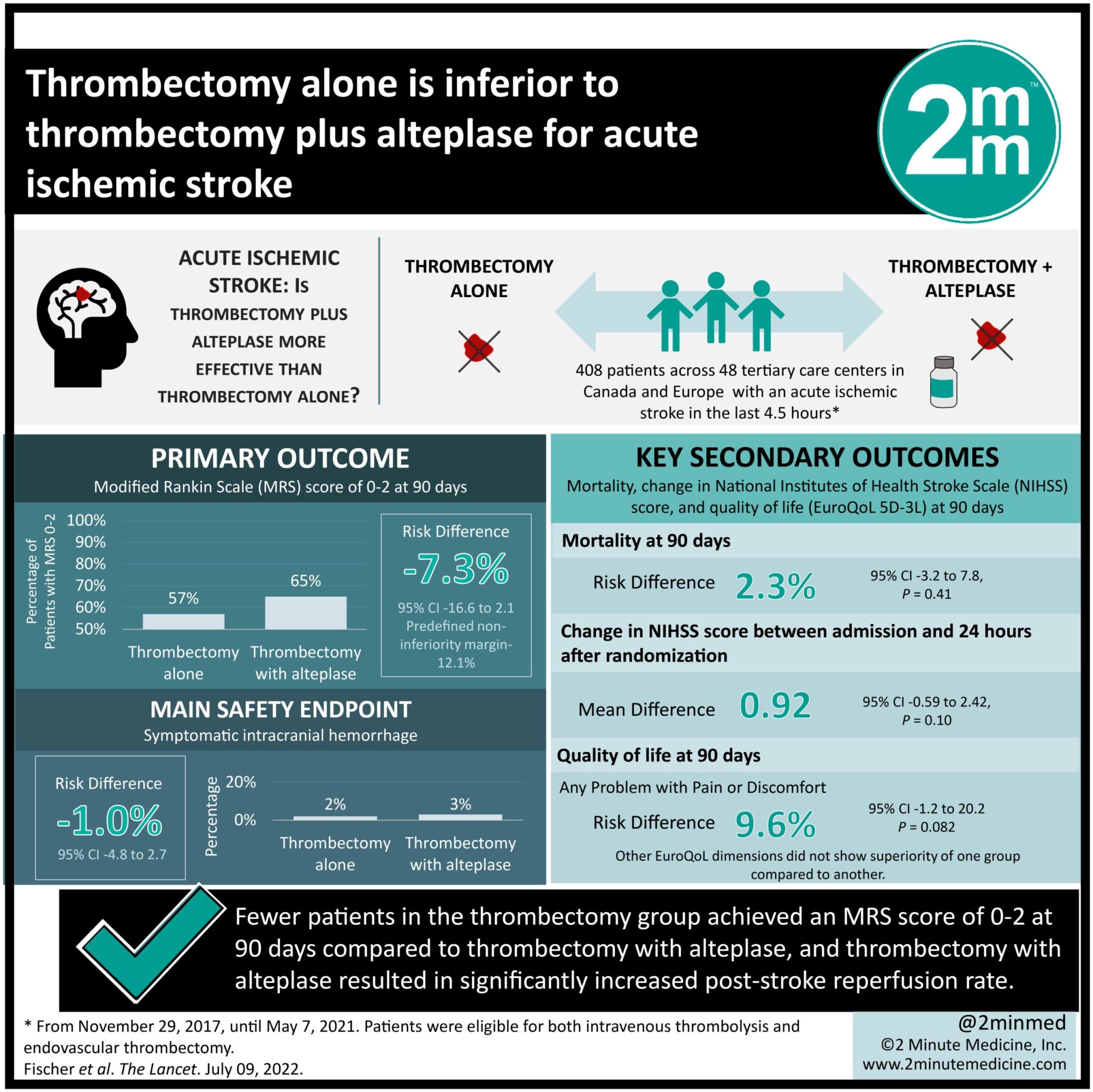1. Fewer patients in the thrombectomy group achieved an MRS score of 0-2 at 90 days compared to thrombectomy with alteplase (57% vs. 65%).
2. Thrombectomy with alteplase resulted in significantly increased post-stroke reperfusion rate.
Evidence Rating Level: 1(Excellent)
Study Rundown: Thrombectomy with alteplase is touted to be the first-line therapy for eligible patients presenting with acute ischemic strokes. However, whether the efficacy of thrombectomy alone is comparable to thrombectomy with alteplase remains unclear. This randomized controlled trial aimed to determine whether thrombectomy alone was non-inferior to thrombectomy with intravenous alteplase in patients hospitalized with acute ischemic stroke. The primary outcome was a Modified Rankin Scale (MRS) score of 0-2 at 90 days while the main safety endpoint was symptomatic intracranial hemorrhage. Key secondary outcomes included mortality, change in National Institutes of Health Stroke Scale (NIHSS) score, and quality of life (EuroQoL 5D-3L) at 90 days. According to the study results, fewer patients randomized to thrombectomy alone achieved a MRS score between 0-2 compared to thrombectomy plus alteplase. Additionally, the proportion of patients with successful reperfusion was significantly lower among those who received thrombectomy only compared to thrombectomy with alteplase. This study was strengthened by a large sample size, longitudinal follow-up, and inclusion of individuals with similar baseline characteristics.
Click to read the study in The Lancet
Relevant Reading: Endovascular Thrombectomy with or without Intravenous Alteplase in Acute Stroke
In-depth [randomized-controlled trial]: From Nov 29, 2017, and May 7, 2021, 5215 patients were assessed for eligibility across 48 tertiary care centers in Canada and Europe. Included were patients with an acute ischemic stroke in the last 4.5 hours and were eligible for both intravenous thrombolysis and endovascular thrombectomy. Altogether, 408 patients (201 to thrombectomy and 207 to thrombectomy with alteplase) were included in the final analysis. Among those randomized to thrombectomy and alteplase, the median interval between arrival at the emergency department and first dose of alteplase was 55 minutes. Regarding the primary outcome, fewer patients with thrombectomy achieved a MRS score of 0-2 at 90 days compared to thrombectomy with alteplase (57% vs. 65%, risk difference [RD] -7.3%, 95% confidence interval [CI] -16.6 to 2.1; predefined non-inferiority margin = -12.1%). This was also the case for successful post-stroke reperfusion rates (91% thrombectomy vs. 96% thrombectomy with alteplase; RD -5.1%, 95% CI -10.2 to 0.0, p=0.047). Both groups were comparable for symptomatic intracranial hemorrhage (2% thrombectomy vs. 3% thrombectomy plus alteplase, RD -1.0%, 95% CI -4.8 to 2.7). Findings from this study suggest that for patients eligible for thrombolytic therapy, thrombectomy alone was inferior to thrombectomy with alteplase for management of acute ischemic strokes.
©2022 2 Minute Medicine, Inc. All rights reserved. No works may be reproduced without expressed written consent from 2 Minute Medicine, Inc. Inquire about licensing here. No article should be construed as medical advice and is not intended as such by the authors or by 2 Minute Medicine, Inc.



